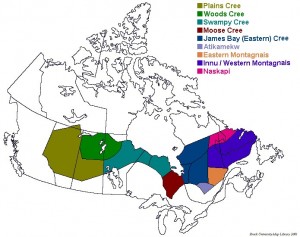In Canada, the Cree language has several dialects and is spoken across a vast area from Labrador to western British Columbia (Cree Cultural Institute). The map below outlines regions in which various Cree dialects are spoken (ibid).
Sakāwithiniwak or Woodland Cree, refer to themselves as Nîhithaw in their own dialect (Saskatchewan Indian Cultural Centre, “Woodland Cree History”). They are the largest indigenous group in northern Alberta and are part of the Algonquian language family. Traditionally, the Woodland Cree relied on hunting, fowling, fishing, and collecting wild plant foods for sustenance (Encyclopedia Britannica, “Cree”).
The origination of the word “Cree” derives from the short form of a cross variation of the Ojibwa word “kistanowak” (people of the north) and the Jesuit equivocal word “kristinue” (Saskatchewan Indian Cultural Centre, “Woodland Cree History”). Methodist missionary James Evans developed the Cree syllabic writing system in 1840s (ibid). Syllabic writing was made popular among the Crees (liyiyuuschii) in the last few decades of the 19th century (ibid). This development led to the translation of the bible into Cree.
In Cree culture, symbols carry values, meanings and represent relations between humans and nature. Four arrows in Cree culture are used to depict four directions and seasons: 1) The North or Kewatin, represented by the color white 2) The South or Sawin – known as the healing wind – represented by the color yellow 3) The East or Wapun keeps the sun and releases it every morning for its journey across the heaven; represented by the color red and 4) The West or Nepawanuk (“the place where the sun goes down”) is represented by the color black (Cuthand, 2007, p.2-4). The number four is considered a sacred number in Cree culture and thus ceremonies that involve dance or prayers are repeated four times (ibid).


